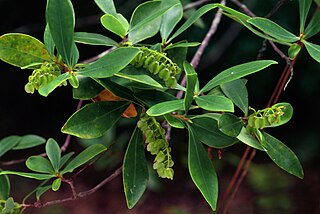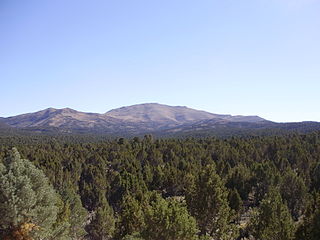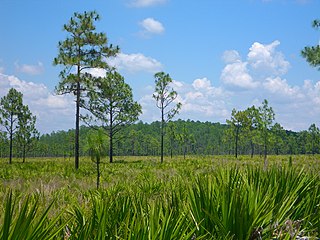Related Research Articles

The Okefenokee Swamp is a shallow, 438,000-acre (177,000 ha), peat-filled wetland straddling the Georgia–Florida line in the United States. A majority of the swamp is protected by the Okefenokee National Wildlife Refuge and the Okefenokee Wilderness. The Okefenokee Swamp is considered to be one of the Seven Natural Wonders of Georgia. The Okefenokee is the largest "blackwater" swamp in North America.
Ironwood is a common name for many woods or plants that have a reputation for hardness, or specifically a wood density that is heavier than water, although usage of the name ironwood in English may or may not indicate a tree that yields such heavy wood.

Ptelea is a genus of flowering plants in the citrus family, Rutaceae. The name, of Greek derivation, is the classical name of the elm tree. Carl Linnaeus used that word for this genus because of the resemblance of its fruit to that of the elm. Members of the genus are commonly known as hoptrees.

The Donald E. Davis Arboretum is an arboretum located on the campus of Auburn University in Auburn, Alabama. It is open to the public without charge.

Cyrilla racemiflora, the sole species in the genus Cyrilla, is a flowering plant in the family Cyrillaceae, native to warm temperate to tropical regions of the Americas, from the southeastern United States, south through the Caribbean, Mexico and Central America to northern Brazil and Colombia in South America. Common names include swamp cyrilla, swamp titi, red titi, black titi, white titi, leatherwood, ironwood, he huckleberry, and myrtle.

Cliftonia monophylla, the buck-wheat tree, buckwheat tree or black titi, is a tree native to the southeastern United States. It is the sole species in the genus Cliftonia.

Florida sand pine scrub is an endangered subtropical forest ecoregion found throughout Florida in the United States. It is found on coastal and inland sand ridges and is characterized by an evergreen xeromorphic plant community dominated by shrubs and dwarf oaks. Because the low-nutrient sandy soils do not retain moisture, the ecosystem is effectively an arid one. Wildfires infrequently occur in the Florida scrub. Most of the annual rainfall falls in summer. It is endangered by residential, commercial and agricultural development, with the largest remaining block in and around the Ocala National Forest. Lake Wales Ridge National Wildlife Refuge also holds a high proportion of remaining scrub habitat, while the Archbold Biological Station near Lake Placid contains about 20 km2 (7.7 sq mi) of scrub habitat and sponsors biological research on it.

Pinyon–juniper woodland, also spelled piñon–juniper woodland, is a vegetation type (biome) of Western United States higher elevation deserts, characterized by being an open forest dominated by low, bushy, evergreen junipers, pinyon pines, and their associates which vary from region to region. The woodland's crown height may vary from less than 10 meters up to 15 meters, depending on the site. It may consist of pure stands of pinyon pine, or pure stands of juniper.

Pinguicula ionantha is a rare species of flowering plant in the butterwort family known by the common names Godfrey's butterwort and violet butterwort. It is endemic to the US state of Florida, where it only occurs in the central Florida Panhandle. It is threatened by the loss of its habitat, and it is a federally listed threatened species of the United States.

Smilax laurifolia is a species of flowering plant in the greenbrier family known by the common names laurel greenbrier, laurelleaf greenbrier, bamboo vine, and blaspheme vine. It is native to the southeastern United States, where it occurs along the Gulf and Atlantic coastal plains from Texas to New Jersey, the range extending inland to Arkansas, Oklahoma, and Tennessee. It also occurs in Cuba and the Bahamas.

A cypress dome is a type of freshwater forested wetland, or a swamp, found in the southeastern part of the United States. They are dominated by the Taxodium spp., either the bald cypress, or pond cypress. The name comes from the dome-like shape of treetops, formed by smaller trees growing on the edge where the water is shallow while taller trees grow at the center in deeper water. They usually appear as circular, but if the center is too deep, they form a “doughnut” shape when viewed from above. Cypress domes are characteristically small compared to other swamps, however they can occur at a range of sizes, dependent on the depth.

Nyssa biflora, commonly referred to as the swamp tupelo, or swamp black-gum is a species of tupelo that lives in wetland habitats. Swamp tupelo grows chiefly in the coastal plains from Delaware, eastern Maryland, and southeastern Virginia, south to southern Florida and west to eastern Texas. Its range extends north up the Mississippi Valley to southern Arkansas and west and south Tennessee.

A strand swamp or strand is a type of swamp in Florida that forms a linear drainage channel on flatlands. A forested wetland ecological habitat, strands occur on land areas with high water tables where the lack of slope prevents stream formation. Strands are more linear than the cypress dome swamps that form in more rounded depressions and are fairly similar to floodplain swamps that form further north along streams and rivers.

A bayhead or baygall is a specific type of wetland or swamp habitat. The name baygall is derived from sweetbay magnolia and sweet gallberry holly. Baygalls are recognized as a discrete ecosystem by ecologist and the swamps have been described as "distinct wetland communities in the Natural Communities of Louisiana". Baygall swamps are most often found in the low laying margins of floodplains and bottomlands with little or poor drainage to the main creek, bayou, or river channel. Baygall or bayhead swamps found on slopes and hillsides are sometimes referred to as a forest seep or hanging bogs. Hanging bogs are typically found in hardwood-pine forests. Most baygall swamps are semi-permanently saturated, or flooded.

The Southeastern conifer forests are a temperate coniferous forest ecoregion of the southeastern United States. It is the largest conifer forest ecoregion east of the Mississippi River. It is also the southernmost instance of temperate coniferous forest within the Nearctic realm.
The southern coastal plain blackwater river floodplain forest is a forest system found in Alabama, Mississippi, Florida, and Georgia. These forests occur in the drainages of blackwater rivers and streams whose dark water is caused by high levels of tannins, particulates, and other materials accumulated as they drain through swamps and marshes. The water has little mineral sediment and few suspended clay particles.

The Southern coastal plain nonriverine basin swamp is a wetland system found along the southern Atlantic coastal plain and the eastern Gulf coastal plain, and extending into the Florida peninsula. These wetlands occur in large, seasonally flooded depressions away from rivers. Sites are often forested by trees including bald cypress, swamp tupelo, evergreen shrubs, and hardwoods. Slash pine is sometimes found. Characteristic shrubs include buckwheat tree, swamp cyrilla, fetterbush lyonia, and laurelleaf greenbrier.
The east Gulf coastal plain near-coast pine flatwoods are forests and woodlands found in the eastern Gulf coastal plain, in the states of Alabama, Florida, Georgia, Louisiana, and Mississippi. They take the form of forests and woodlands on broad, sandy flatlands. Fires are naturally frequent, occurring every one to four years.
Vaccinium formosum, with common names highbush blueberry, southern blueberry, southern highbush blueberry, and swamp highbush blueberry, is a species of blueberry that is native to the Southeastern United States.
References
- ↑ Sunquist, Fiona, Melvin E. Sunquist & Les Beletsky (2007) Travellers' Wildlife Guides: Florida. Interlink Books ISBN 9781566566513
- ↑ "Cliftonia monophylla". www.wildflower.org. Retrieved 2017-05-07.
- ↑ "Cyrilla racemiflora". www.wildflower.org. Retrieved 2017-05-07.
- ↑ Goff, John Hedges (2007 reprint) Placenames of Georgia: Essays of John H. Goff. Athens: University of Georgia Press. ISBN 9780820331294